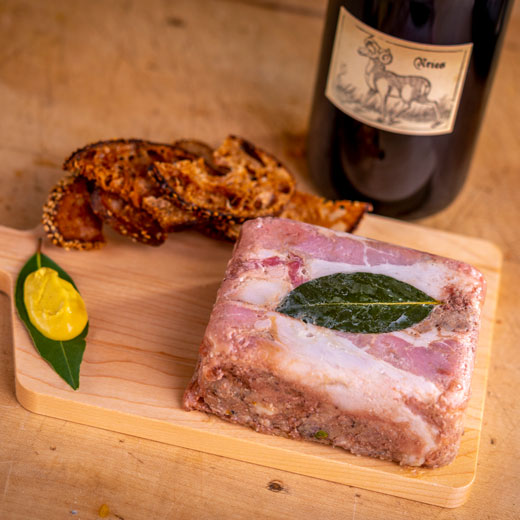Duck Pâté
I love to cook this pâté in smaller vessels such as round or square ramekins. The pâté can be vacuum sealed and frozen then pulled out as needed for small gatherings or an impromptu Banh Mi sandwich. I like the look of a petit whole pâté on a small board with all the fixings. You can also make a large terrine and then cut it into pieces, vacuum seal and freeze. If you can’t find pork fatback, substitute fatty bacon. The finished pâté will have a bit of smoked flavor from the bacon but it will work out just fine. Serves 12-14
Ingredients
- 2 duck breasts (about 1½ pounds), cut into ½ inch pieces
- 3 small garlic cloves
- 2 tablespoons brandy or Armagnac
- ½ teaspoon freshly ground black pepper
- ½ teaspoon orange zest
- Extra-virgin olive oil
- 6 fresh or dried bay leaves
- Kosher salt
- 1 pound boneless pork shoulder, chilled
- ¾ pound pork fatback or bacon chilled
- 2 large eggs, beaten until uniform
- 1 tablespoon chopped thyme leaves plus 3 sprigs
- ½ teaspoon ground cloves
- ½ teaspoon ground ginger
- ¼ teaspoon ground nutmeg
- ¼ teaspoon piment d’Espelette or paprika
- ⅓ cup shelled pistachios
- 3 tablespoons dried green peppercorns
- 12–15 pieces thinly sliced bacon
Directions
1. Use a sharp knife to cut the duck breasts, meat and skin into ½” cubes. Transfer the meat to a medium bowl. Add 1 finely chopped garlic clove, brandy, black pepper, orange zest, 1 tablespoon olive oil, 3 torn bay leaves and 1 teaspoon salt. Mix well to coat the duck pieces. Cover and refrigerate for at least 1 day and up to 3 days, to allow the flavors to come together. (The longer the duck marinates, the tastier the pâté.)
2. Season the pork and back fat with 2 teaspoons kosher salt. Coarsely grind the pork shoulder and backfat together. If you don’t have a grinder call your butcher and have him grind it for you in advance, you can mix in the salt after it is ground. Transfer ground meat to medium bowl and set aside in the refrigerator chill.
3. Finely chop the remaining garlic and add to a large bowl. Add reserved pork and fat. Remove the torn bay leaves and any accumulated juices from the marinated duck breast and add to mixture.
4. Add eggs, chopped thyme, cloves, ginger, nutmeg, piment d’Espelette, and 2 teaspoons salt. Mix the ingredients together with your hands until well combined.
5. To taste for seasoning make a small 1 inch patty of the mixture. Heat a small skillet over medium-high heat and then add a little olive oil and the meat patty. Brown on one side flip and brown on the other side until cooked through, about 3 minutes.
6. Cool to warm, taste; adjust seasoning accordingly and test again. You need the meat to be well-seasoned otherwise the pâté will taste bland when it is served chilled.
7. Cover bowl with plastic wrap and refrigerate for at least 1 day and up to 3 days, to allow the meats to cure and the flavors to come together.
8. To assemble the pâté, remove bay leaves from duck mixture and discard. Use a spoon or gloved hands to fold the duck and any juices from marinade into the pork mixture.
9. Add the pistachios and peppercorns and mix until evenly distributed; set aside in the refrigerator.
10. To assemble the terrine, line the bottom of a 1½-quart rectangular terrine mold with 4 evenly spaced thyme sprigs and 3 bay leaves. Place bacon crosswise along the bottom and up the sides of the mold, covering the herbs. You can also use several smaller molds.
11. Spoon the meat–duck mixture into the terrine mold and gently smooth the top with the back of a spoon. Lay 4 strips bacon lengthwise across the top of the pâté.
12. Preheat the oven to 325 degrees F. Position a rack in the middle of the oven.
13. Cover the top of the pâté with 2 sheets of aluminum foil; crimp foil around edges of the mold to form a tight seal. Place terrine mold in a 9” x 13” baking dish. Transfer dish to oven rack.
14. Pour in enough boiling water that it reaches ½” up the sides of the terrine. Bake the pâté until an instant-read thermometer inserted into center reads 145°, about 1½ to 2 hours. Transfer baking dish to a rack; remove foil. Smaller molds will take about 1 hour 15 minutes so check after 1 hour.
15. Cut a thick piece of cardboard to fit inside the rim of the terrine mold. Cover with aluminum foil so it doesn’t get soggy with fat and juices. Weight the pâté to compact the terrine and make it easier to slice. Place three 15-ounce soup cans atop cardboard; let sit in water bath for 1 hour; remove. Refrigerate pâté (in its mold) for at least 1 day and up to 4 days.
16. To serve, slide a knife along edges of pâté to loosen it. Invert the pâté onto a cutting board and slide a butter knife along one short edge to free the pâté from the mold. Cut into ¾” slices and serve with baguette, Dijon mustard, and cornichons.


